From Mr. and Mrs. Noda, Akiruno City Tokyo
It has now been nine years since I met David at his first exhibition. A decade is a long time, and there have been many changes in his life. Our family moved away from Hamura - to Akiruno City - but still waited eagerly each month for the print to arrive.
There were changes in the prints too, during that time: the delicacy of the hair carving, the blending of the colours ... We also enjoyed the many stories in the 'Hyakunin Issho' newsletter, both about the printmaking work, and about David himself. The 100 prints will become our family treasure.
Thank you very much David, and congratulations on completing the 100 prints!
* * * * *
From Ms. Rebecca Marck, Nagano City
I'm sure I won't be the only person to say "How quickly time flies!" as the end of this ten-year odyssey approaches. It may not have passed so quickly for you, David Bull, laboring at the workbench month after month, year after year. But to me, it seemed that the little circles on the front of the 'Hyakunin Issho' newsletters piled up overnight, as did the prints themselves.
I can remember so clearly the time and place I first got involved in this "opus maximus." I was a newcomer to Japan when one day I read Jean Pearce's column in the Japan Times about a fellow who was launching a ten-year enterprise involving woodblock carving. Minutes later I was on the pay phone in the hall at work, ringing you up to enquire. You were gracious enough to offer to send a couple of prints on approval. I remember being mightily impressed that you would take that risk with somebody you didn't know. I don't know what motivated me to join up initially. I suppose along with delight at participating in such an intricate scheme was the notion of being a sort of "patron of the arts." It wasn't until later that a genuine appreciation for the prints in and of themselves began to emerge. That came after you had educated me somewhat, especially in how to look at the prints.
I was a few months late getting into the endeavor, but you explained that I could "double up" until I caught up with those who had gotten in on the ground floor. It felt a little like trying to pay off a house mortgage early, but I surely didn't want to miss having the first few prints. So, I took the plunge.... At that time I had hardly any knowledge of the cultural background of 'Hyakunin Isshu' and I certainly didn't envision staying in Japan long enough to collect all the prints. Rather, I thought I'd join up for a year or two, then return to my home country and perhaps give away a couple of the prints to special friends.
Lo and behold! Ten years later, I'm still here, and I would no more part with any one of these 100 prints than I would sell off a child of my loins. Between your research and my own, I feel my knowledge of the Hyakunin Isshu has grown a hundredfold. But these lovely prints have only piqued my curiosity, if the truth be told. There is much more to be learned, as you keep reminding us.
Owning these unique works of art makes me feel special. I have enjoyed being part of an ongoing enterprise, as opposed to plopping down a pile of money and walking out of a shop with an 'objet d'art.' It has been fun to watch you grow as an artist and to observe your confidence developing along with your skill. I must admit I agonized much less than you when it came to decisions such as whether or not to deviate from the original color palette. (I'm very glad you did, by the way, and I appreciated being consulted, even if it was after the fact.)
The explanations accompanying the prints were invaluable additions to the endeavor. I must admit I often read the explanation before opening the print folder. Doing it in that order, seemed to prepare me for viewing the print. Sometimes, based on your explanation, I'd try to guess what the print would look like before I actually saw it. (I was seldom right, I must confess!) Without those explanations, my appreciation of the prints would have been greatly diminished.
I also want to express my thanks for your efforts on the newsletter. It offered insights into the project which deepened my understanding of it. Your explanations and introductions of the suppliers and craftspersons who supported you really enhanced my sense of holding a bit of history and culture in my hand whenever I opened one of the packages.
I suspect I reflect the sentiments of most of the project aficionados in saying that, most of all, we appreciate your steadfastness. In our own way, each of us marvels at your vision of what this project could be and your tenacity in bringing it to fruition. As best we amateurs can, we appreciate the painstaking effort it took to do the carving and printing itself. But more than that, we admire the sheer gumption it took to stay the course and "keep your eye on the prize."
It has been a pleasure being involved in an enterprise as sweeping as this was. I feel privileged to have been a part of it. And I wish you godspeed on your next challenge, whatever it might be. With admiration and appreciation, not to mention celebration, let me just say, Congratulations!
* * * * *
From Mr. Shigeyoshi Ushiro, Kashiwara City Osaka
Well, here we are ... I want to say 'congratulations' ... but I feel also somewhat sad. David has again come to a major turning point in his life; but where most people seem to drag their way through life, I think that he will always keep his 'young' outlook.
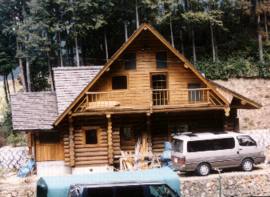
Ushiro-san's ten year project is also nearing completion!
* * * * *
From Mr. and Mrs. Oba, Kawasaki City
I first heard about David's work when I read a magazine one day which carried his photograph, along with his print of Ono no Komachi. Ten years has passed since that time ... Receiving the prints from him regularly every month has become an integral part of our lives.
Although as a child I played 'Bozu Mekuri' and 'Karuta' while huddled under the kotatsu in the wintertime, my connection to those things has long ago been cut, and I had not expected to 'find' them again later in life.
I am not such an expert on woodblock prints, but through receiving the prints one by one, and reading the accompanying letters, I have become deeply impressed with your sincerity. Now that the Hyakunin Isshu Series is completed, I hope that your sense and abilities will continue to flourish.
* * * * *
From Larry and Yuki LaCoss, Shinjuku Tokyo
Sincerest congratulations on an outstanding job well done! Yuki and I have been collecting art pieces for 25 years and we are very proud that your 10-year project is part of that collection. At the time we met you, we had been helping beginning artists for several years. Now, all collectors are excited to 'discover' a new talent and you have been one of ours. I know that you'd rather I talk of your work, but it is simply a result of who you are and a product of your dreams. We have been thrilled and privileged to get to know you and to watch you grow and master your craft. We hereby hoist our Sapporo beers to your continuing successes.
* * * * *
From Himi and Fumi, Vancouver Canada
100 prints, finally over! It was a short ten years. We can't even remember the time Daddy started the woodblock prints but we do remember his big bench piled high with paper and him sitting and carving or printing with Mimi the cat on his lap. Before when people interviewed us and asked "What do you think of Daddy's woodblock prints?" we would answer, "I don't know", but now when we think about it, we think it's really unique, and it is nice to bring back old crafts that people have forgotten and remind them how beautiful woodblock printing can be. We feel it is also a great thing that the job he is doing is an entrepreneurship. We hope he can keep his great imagination and continue being a great printmaker and dad.

* * * * *
From Roy and Betty Bull, Halifax England
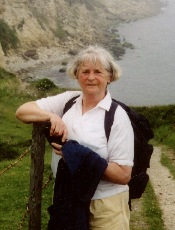 Dad and I look forward to your newsletter. It has been for us a window to a different world, but even as I write that, I know I am wrong.
Dad and I look forward to your newsletter. It has been for us a window to a different world, but even as I write that, I know I am wrong.  The buildings, the language, and the customs may be different, but there is so much we have in common. The Moms worry the same about their families, the children about their homework. I think we are more alike than different. I seem to remember lots of laughter and fun while on our visits to Hamura, and lots of kindness. It is interesting to think that I can find my way around Hamura just as easy as I can round Halifax. My neighbour also enjoys your newsletter, and her granddaughter always has something interesting for show and tell.
The buildings, the language, and the customs may be different, but there is so much we have in common. The Moms worry the same about their families, the children about their homework. I think we are more alike than different. I seem to remember lots of laughter and fun while on our visits to Hamura, and lots of kindness. It is interesting to think that I can find my way around Hamura just as easy as I can round Halifax. My neighbour also enjoys your newsletter, and her granddaughter always has something interesting for show and tell.
Are we allowed to say how proud we are of you? And can we use this opportunity to thank all the people who have made you so welcome to their country? We look forward to meeting all our friends again in January.
* * * * *
From Ms. Reiko Furuichi, Tokyo
Hello to the readers of 'Hyakunin Issho'! I am Reiko Furuichi, a television producer, and I've been very interested in David and his collectors. The 'Hyakunin Issho' has been a really important theme for me since I met him while doing an interview some 6 years ago. May I tell you why?
I visited the carver Susumu Ito with David in 1992. Mr. Matsuzaki the printer had arranged the visit for us. (David has already written about this visit in this newsletter, but we TV people have another side to the story!)
Mr. Ito was an elderly 'shokunin' with sullen looks. I didn't even know how to talk to him, but began the interview with my heart in my mouth. It was a strange scene that David and Mr. Ito made, sitting side by side. Their body sizes were completely different and we were not able to shoot the scene in the usual way (Mr. Ito was small and worked with his body hunched over). David felt small sitting beside the 'master', but when we looked at them through the camera lens, it seemed just the reverse; it looked like as though David was bullying Mr. Ito.
So it was quite a difficult situation for our crew. The cameraman was struggling to take pictures of them as they sat on the tatami with tools scattered here and there. He had to work very unnaturally, shooting between their heads and shoulders, and he looked at me quite reproachfully. And what was worse, was that David's ability to listen to Japanese language was far from perfect at that time, and the way Mr. Ito spoke was not easy to understand even for us Japanese. Would this interview work out? We were quite concerned ...
And what happened? Well, Mr. Ito didn't care about the camera at all and eagerly started to tell a lot of things to David. We felt his extraordinary desire to pass on his knowledge to David. Two people have the subject in common. One is eager to tell what he knows, and the other is eager to learn it. It seems that nothing can disturb them. As time went by, the things that Mr. Ito said to David became more and more specific, and at last he was teaching David the 'secrets of carving' with 90% gestures and 10% Japanese that consisted of just isolated words. It seemed as though he was trying to teach David everything he knew in this few hours. It would take a few years to teach them at school. David listened to him with all his heart and mind and strength. Gradually Mr. Ito became to look big for us, too.
One knife came to David's hand and then back to Mr. Ito's hand. This was repeated again and again. It was a happy encounter beyond every difference - age, language, or nationality. Mr. Kenichiro Nakaba, the cameraman, kept taking shots of their hands as much as he could.
After we returned to our office, we talked about how beautiful the hands of the two men were. Why did Mr. Ito try to teach his techniques to David so eagerly? What was David trying to do? Do we really understand Japanese woodblock prints? What is happening in the traditional culture of Japan? ...
As the result of these discussions, we came to realize that we wanted to make a program of this ten year project that David and the people around him are involved in, even though it was not any important event for society and there would not be any dramatic scenes. I'm very interested in this "Hyakunin Issho" circle. I feel like this ring will change in its quality and be a very big power in the near future.
The program will be completed when David's Hyakunin Isshu series is completed. I'm looking forward to seeing you all at the completion party!
* * * * *
The next five messages are from the five ladies who have been my 'backup crew' for the last ten years. Although I have made the actual prints completely by myself, the project has entailed a tremendous amount of peripheral work - making the packaging for the prints, doing all the wrapping and shipping, translating the monthly 'letters' and these newsletters ...
When I asked them for some comments for these pages, I had a suspicion how they would reply, and I was correct; they wanted to remain unseen in the background. But I cannot let them remain unseen - their assistance has been an essential part of the project. I hope you will join me in offering them a sincere "Thank you very much" ...
From Mrs. Akemi Doi (newsletter and essay translation)
 The first time that David asked me to translate his newsletters was in September of 1993. As I was learning English, and of course also interested in his work, I was happy to start translating his newsletters, but it was not as easy to write good Japanese as I first thought.
The first time that David asked me to translate his newsletters was in September of 1993. As I was learning English, and of course also interested in his work, I was happy to start translating his newsletters, but it was not as easy to write good Japanese as I first thought.
His request to use as few 'katakana' words as possible particularly made my work more difficult. (When we use foreign words directly in Japanese we use the 'katakana' script.) People who have preserved Japanese traditional culture are usually older than him, and he wanted me to write Japanese that would be readily understandable to such people. I basically agreed with him as I don't like the trend of using English words so much in Japanese conversation; however, we don't have equivalent Japanese words to all English words, and there are a lot of English words that are used in common in Japanese, for example 'image', 'design', and 'group'. But he wanted me to translate even such words into Japanese if I possibly could. Or sometimes he said that he just didn't like the word that I had used. For example, 'paso-con' (an abbreviation of 'personal computer', a word we use very often). Sometimes I accepted his requests, and sometimes he accepted my katakana words.
However, I always enjoyed checking my translation with him. Looking at the prints he had just made, he talked about the prints and other stories that he hadn't been able to write about in that month's essay. Sometimes he told things that he didn't want to speak about publicly. It was very interesting work!
I know I was not perfect, but I tried to make his ideas understandable to his Japanese collectors as well as I could. When I saw people reading my translation works next to his prints, I was happy and proud of being part of this great project.
When I started this work, my second daughter was one year old, and she frequently interrupted David and I while we were checking my translations. However, he was always kind to my girls. At times, he gave them toys he had made for his daughters, or he played with them on his computer. Our girls also like him.
Thank you very much, David. I really liked this work.
* * * * *
From Mrs. Miyoko Ashida (packaging and shipping)
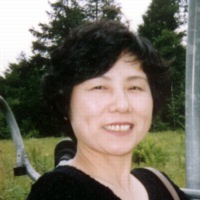 I first met David when one of my sons joined his English conversation classes, and it was a short time later that he asked me to assist him with his work. My work would be to make the folders to hold the prints, and then once David had finished and signed them, to put them in, wrap and send them out so that the collectors would receive them safely. He said that it would be all hand work, but I was surprised to see that he had made by hand even the jigs for making the folders.
I first met David when one of my sons joined his English conversation classes, and it was a short time later that he asked me to assist him with his work. My work would be to make the folders to hold the prints, and then once David had finished and signed them, to put them in, wrap and send them out so that the collectors would receive them safely. He said that it would be all hand work, but I was surprised to see that he had made by hand even the jigs for making the folders.
The work involved using both spray-type glue and stick-type glue to attach various papers to a backboard. Spray glue? I had never even heard of such a thing. If the glue wasn't just right, the folders would come apart. Cutting the paper I knew I could handle - that was with just a simple cutter knife! But if I used too much pressure it would leave marks on the paper; if I didn't cut exactly straight, the folder edges would be uneven ... Not the best work for a clumsy one like me ... It took quite a while, and lots of advice from David, before I was able to produce good work ...
These days, Ichikawa san and Ishikawa san are doing this work. David-san, thank you very much for the meaningful three years.
* * * * *
From Mrs. Kimiko Ishikawa (packaging)
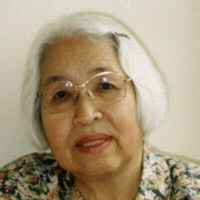 I first met David at the Hamura Swimming Centre. At first I thought he was just an unkempt foreigner with a bushy beard, but I learned that he could speak Japanese well, and actually knew a lot about Japan.
I first met David at the Hamura Swimming Centre. At first I thought he was just an unkempt foreigner with a bushy beard, but I learned that he could speak Japanese well, and actually knew a lot about Japan.
It was about five and a half years ago that I became one of the assistants working with him on his ten-year project of making the Hyakunin Isshu prints; helping to make the folders that contain the prints, and with the shipping. I was worried about whether or not I would be able to do the job, but he carefully showed me what to do. At first I was very surprised to find just how detailed the work was, almost nerve-wracking. On occasion I made mistakes and the work was rejected.
During the hot summer, when I was making the folders I had to avoid having my perspiration drip down onto the Torinoko paper, and in the winter, because the spray adhesive can't be used indoors, I had to work with the windows wide open, my body trembling in the cold. The work was very hard for me. But David worked hard to make the beautiful prints, and they would be treasured by the collectors, so I did the best that I could.
Congratulations on this ten years of making such delicately carved, and perfectly printed 100 prints. Now at the end of these long six years of helping with this work, I am filled with emotion. I am very happy to have been able to help, even such a little. Sincere best wishes for the next project.
* * * * *
From Mrs. Hitomi Ichikawa (packaging and shipping)
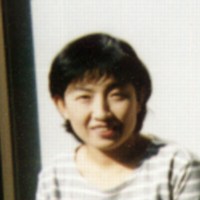 It was about five and a half years ago that I started this job of helping David's work - making the folders in which the finished prints will be stored. The materials and tools - the paper, the spray glue, the cutters - were not easy for me to handle at first, but I am very pleased to have been able to assist David in his work of making 100 prints over the ten years.
It was about five and a half years ago that I started this job of helping David's work - making the folders in which the finished prints will be stored. The materials and tools - the paper, the spray glue, the cutters - were not easy for me to handle at first, but I am very pleased to have been able to assist David in his work of making 100 prints over the ten years.
* * * * *
From Sadako Ishizaki (translations, etc.)
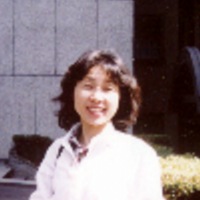 It was about five years ago; when visiting the local swimming pool sometimes, I would notice him sitting after his swim: arms clasped around his knees, staring out over the surface of the pool, this thin foreigner with the scraggly beard. What kind of gloomy guy was this? I felt the impulse to poke him to see if I could make him laugh ...
It was about five years ago; when visiting the local swimming pool sometimes, I would notice him sitting after his swim: arms clasped around his knees, staring out over the surface of the pool, this thin foreigner with the scraggly beard. What kind of gloomy guy was this? I felt the impulse to poke him to see if I could make him laugh ...
I can't find the words to properly describe him, but I found myself attracted to some kind of depth in his eyes. Five years have now passed. During that time I gradually came to understand him, a soft-looking but strong-minded person, who for good or bad, will never quite 'grow up', but will always retain his youthful enthusiasm.
It seems that many things happened during these ten years. I am sure though, that nothing can stop him from reaching his goals, either then, or from now ...